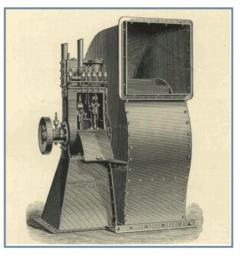Sturtevant fan

This early centrifugal fan devised by Benjamin Franklin Sturtevant was driven by a steam engine.
Primitive wooden fans are depicted in 16th century German woodcut illustrations showing mine ventilation methods. These paddle-bladed fans were enclosed in a square wooden casing and cranked by hand or driven by windmills. A hand-cranked fan was installed in the House of Commons in 1736, but the forerunners of today’s centrifugal fans only appeared from the mid-19th century. Benjamin Franklin Sturtevant, the American fan engineer, was the most important name in ventilation during the second half of the 19th century. However, he started out as a cobbler and shoemaker. Concerned with the heat in his workshop, in about 1850, he rigged up a stand with a disc fan run by a belt connected to a foot pedal. He formed the Sturtevant Blower Company in Boston in 1855 and developed various types of fan. Later, as B. F. Sturtevant, the firm produced large centrifugal fans with matching steam engines and drives. (Electric motors for fans came only into common use in the early 20th century). By the turn of the century, Sturtevant was producing fans with cased air heaters attached and also dual-duct apparatus. The business prospered and sold fans for ventilation, exhaust systems and for boiler mechanical draught applications, virtually monopolising the supply of boiler fans for American ships. The business opened offices in London, Glasgow, Stockholm, Berlin, Milan and Amsterdam. Where Sturtevant led, others were to follow and efficient centrifugal fans became an essential feature of HVAC installations.


